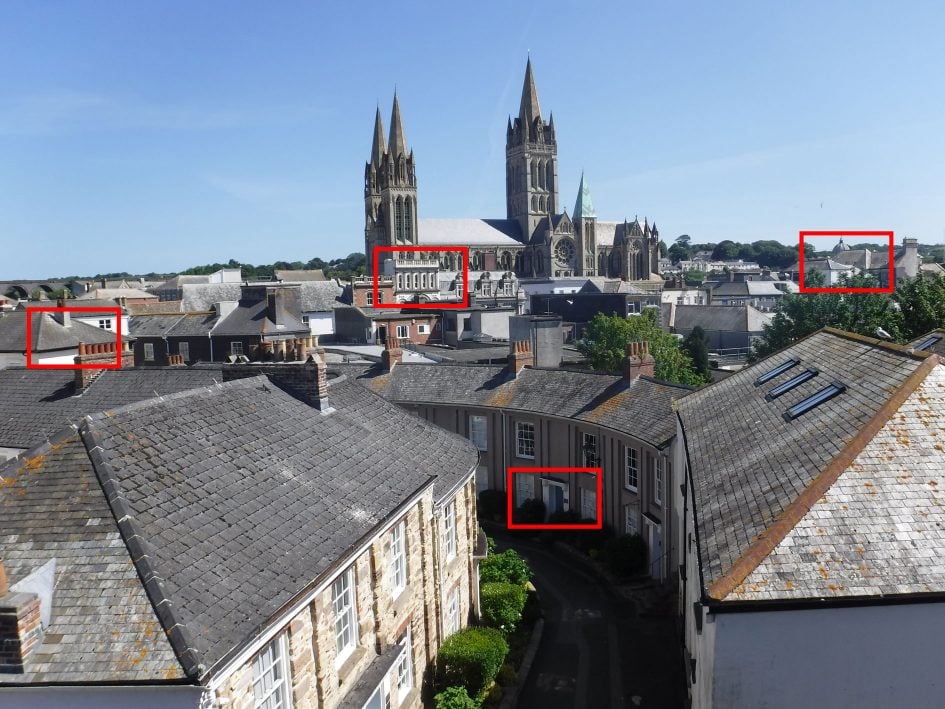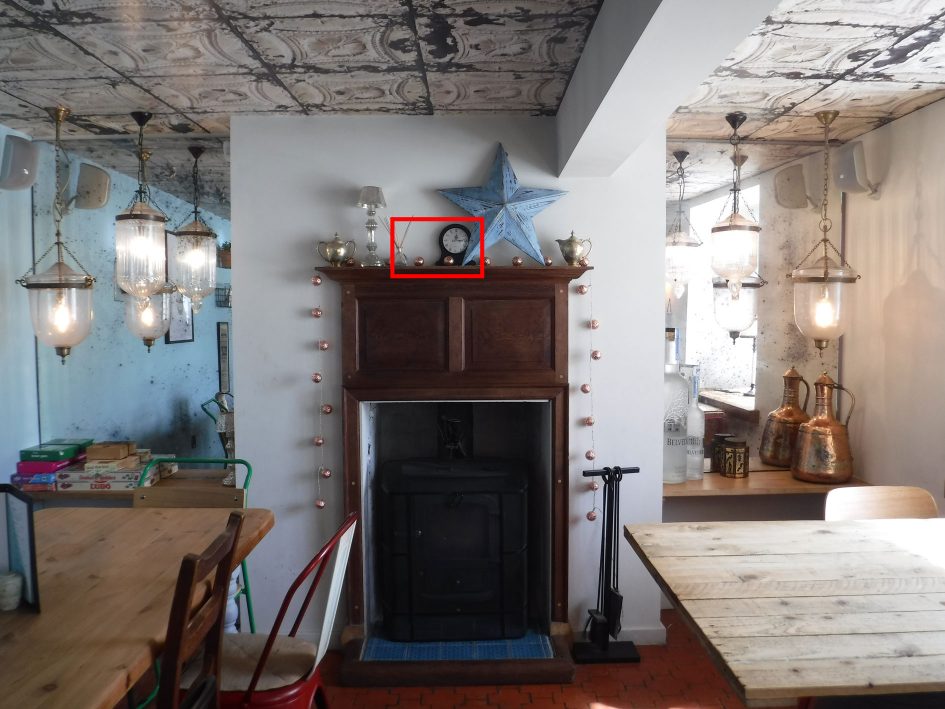Fujifilm Finepix XP120 review
-
-
Written by Ken McMahon
Quality
To test real-life performance, I shot this scene with the Fujifilm FinePix XP120 and the Olympus TOUGH TG-5 using their best quality JPEG settings and at their base 100 ISO sensitivity setting. Both cameras were mounted on a tripod and image stabilisation was disabled, the sensitivity was manually set to 100 ISO and Program auto mode was selected for the exposure. The FinePix XP120 selected an exposure of 1/350 at f6.2 and for the TOUGH TG-5 it was 1/160 at f9 – effectively giving the same exposure.

As the Finepix XP120 has a slightly narrower 28mm equivalent wide-angle, I zoomed the TOUGH TG-5 in a tad to match the angle of view. The XP120 has a 16.4 Megapixel sensor compared with 12 Megapixels on the TOUGH TG-5, so the XP120’s crops show a smaller area with larger detail. As usual, the crops below are taken from the areas marked in red above.
The FinePix XP120 doesn’t get off to a sparkling start, but crops taken from the edge of the frame, where the lens and sensor both have a difficult job to do, rarely show a camera at its best. This crop is pretty soft, and lacking in detail. The edges of the window frame aren’t sharp and you can’t really make out the detail in the roof tiles or the brickwork in the chimney stack. If you compare it with the crop on the right from the Olympus TOUGH TG-5 there’s a lot more detail and it’s a lot sharper than the XP120.
So how does the FinePix XP120 do closer to the middle of the frame? We’ll a little better, but it’s still not quite getting there. This part of the scene has a lot of fine detail in the cathedral stonework and the facades of the buildings in the foreground, but the XP120 isn’t capturing it. The intricate detail in the cathedral and the roof tiles and brickwork that are crisp and detailed in the crop on the right from the TOUGH TG-5 just aren’t visible in the XP120 crop.
The next crop is from an area of shadow in the lower half of the frame, again near the middle. You’d expect to see a little bit of noise here from a compact sensor and both crops have visible noise texture. On the FinePix XP120 crop, however, it’s quite severe for 100 ISO and is further obscuring the image detail. Finally, in the fourth crop from the right edge of the frame, compare the amount of detail in the trees and the roofs of the TOUGH TG-5 crop on the right with the FinePix XP120 crop on the left. It’s the same story, the Finepix XP120’s lens and sensor combination isn’t capable of rendering the finer details in this scene and is no match for the Olympus TOUGH TG-5. On a more positive note, the XP120 doesn’t suffer from colour fringing to anything like the same degree as the Olympus.

Above left: Fujifilm FinePix XP120 at 5mm (28mm equivalent) f6.2, 100 ISO.
Above right: Olympus TOUGH TG-5 at 5.14mm (28mm equivalent) f9 100 ISO.

Above left: Fujifilm FinePix XP120 at 5mm (28mm equivalent) f6.2, 100 ISO.
Above right: Olympus TOUGH TG-5 at 5.14mm (28mm equivalent) f9 100 ISO.

Above left: Fujifilm FinePix XP120 at 5mm (28mm equivalent) f6.2, 100 ISO.
Above right: Olympus TOUGH TG-5 at 5.14mm (28mm equivalent) f9 100 ISO.

Above left: Fujifilm FinePix XP120 at 5mm (28mm equivalent) f6.2, 100 ISO.
Above right: Olympus TOUGH TG-5 at 5.14mm (28mm equivalent) f9 100 ISO.
Fujifilm XP120 vs Olympus TOUGH TG-5 JPEG noise
To examine noise levels under real-life conditions, I shot this scene with the Fujifilm FinePix XP120 and the Olympus TOUGH TG-5 at each of their ISO sensitivities using their highest quality JPEG settings. Both cameras were mounted on a tripod and stabilisation was disabled.
As the Finepix XP120 has a slightly narrower 28mm equivalent wide-angle, I zoomed the TOUGH TG-5 in a tad to match the angle of view. The XP120 has a 16.4 Megapixel sensor compared with 12 Megapixels on the TOUGH TG-5, so the XP120’s crops show a smaller area with larger detail.

The ISO sensitivity was manually set to the lowest available setting and Program auto was selected for the exposure. At 100 ISO the FinePix XP120 selected an exposure of 1/13 at f3.9 and for the TOUGH TG-5 it was 1/30 at 2.2. As usual, the crops are taken from the areas marked in red above.
The first crop from the FinePix XP120 at 100 ISO already shows quite a lot of noise texture, so much in fact that it’s already interfering with image detail and the clock face is looking a little indistinct. If you look at the numerals II and III in the crop on the right from the Olympus TOUGH TG-5 they’re clearly defined with space between each I, but that’s not the case in the XP120 crop on the left.
At 200 ISO there’s a visible increase in the noise and the noise processing is also obscuring image detail – there’s a nasty smudge right in the middle of the clock face that’s obscuring the hands. As you’d expect, both problems become a little worse at 400 ISO, however it’s worth pointing at that other than at 100 percent viewing sizes, this noise won’t be too noticeable.
At 800 ISO though the noise takes on a clumpy, blocky appearance and if I was hoping to make a big print or display a shot taken at this sensitivity setting on a big screen I’d be a bit anxious about the quality. Both 1600 and 3200 ISO will be fine for looking at on your phone, but on anything bigger the noise is going to make a difference.
The comparison with the crops on the right from the 12 Megapixel TOUGH TG-5 tells an interesting story. Right from the start the XP120’s crops are significantly noisier and less detailed. The lack of detail is mainly down to the noise, but also the efforts of the XP120’s processing to try and minimise it. I’d say the difference in noise levels between the two models is between one and two stops. Even if it’s only one stop, that’s quite a significant difference, especially when combined with the TOUGH TG-5’s two stop aperture advantage.

Above left: Fujifilm FinePix XP120 at 100 ISO f3.9. Above right: Olympus TOUGH TG-5 at 100 ISO f2.2.

Above left: Fujifilm FinePix XP120 at 200 ISO f3.9. Above right: Olympus TOUGH TG-5 at 200 ISO f2.2.

Above left: Fujifilm FinePix XP120 at 400 ISO f3.9. Above right: Olympus TOUGH TG-5 at 400 ISO f2.2.

Above left: Fujifilm FinePix XP120 at 800 ISO f3.9. Above right: Olympus TOUGH TG-5 at 800 ISO f2.2.

Above left: Fujifilm FinePix XP120 at 1600 ISO f3.9. Above right: Olympus TOUGH TG-5 at 1600 ISO f2.2.

Above left: Fujifilm FinePix XP120 at 3200 ISO f3.9. Above right: Olympus TOUGH TG-5 at 3200 ISO f2.2.

Above left: Fujifilm FinePix XP120 at 6400 ISO f3.9. Above right: Olympus TOUGH TG-5 at 6400 ISO f2.2.

Above right: Olympus TOUGH TG-5 at 12800 ISO f2.2.
Next check out my sample images or skip back to my in-depth review or final verdict page!
Check prices on the Fujifilm XP 120 at Amazon, B&H, or Adorama. Alternatively get yourself a copy of my In Camera book or treat me to a coffee! Thanks!




